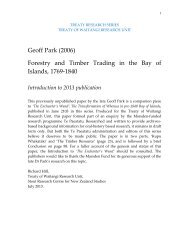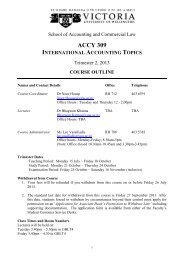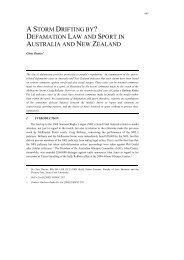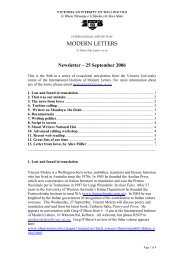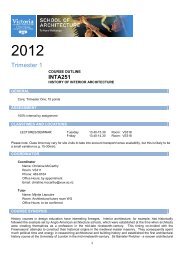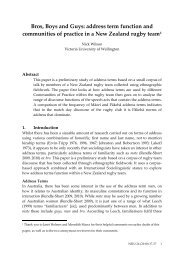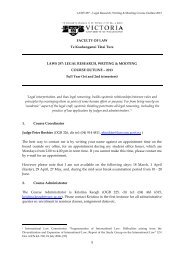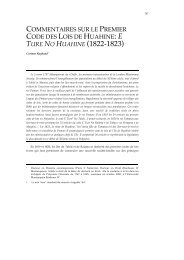Raman Anisotropy Measurements: An Effective Probe of Molecular ...
Raman Anisotropy Measurements: An Effective Probe of Molecular ...
Raman Anisotropy Measurements: An Effective Probe of Molecular ...
Create successful ePaper yourself
Turn your PDF publications into a flip-book with our unique Google optimized e-Paper software.
FULL PAPER<br />
<strong>Raman</strong> <strong><strong>An</strong>isotropy</strong> <strong>Measurements</strong>: <strong>An</strong> <strong>Effective</strong> <strong>Probe</strong> <strong>of</strong> <strong>Molecular</strong><br />
Orientation in Conjugated Polymer Thin Films**<br />
By Hai-Ming Liem, Pablo Etchegoin,* Katherine S. Whitehead, and Donal D. C. Bradley*<br />
Understanding the molecular alignment <strong>of</strong> conjugated polymers within thin-film samples is essential for a complete picture <strong>of</strong><br />
their optical and transport properties, and hence for the continued development <strong>of</strong> optoelectronic device applications. We<br />
report here on the efficacy <strong>of</strong> <strong>Raman</strong> anisotropy measurements as a probe <strong>of</strong> molecular orientation, presenting results for<br />
aligned polyfluorene nematic glass films. Comparison is made with the results <strong>of</strong> optical dichroism measurements performed<br />
on the same samples. We show that in many cases molecular orientation can be more directly characterized by <strong>Raman</strong> anisotropy,<br />
and that it can have a greater sensitivity to the degree <strong>of</strong> molecular orientation than conventional optical dichroism. The fact<br />
that the <strong>Raman</strong> measurements can be readily performed on the same thin films (~ 100 nm thickness) that are required for<br />
optical dichroism means that there is no ambiguity in a direct comparison <strong>of</strong> results. This situation differs from that for standard<br />
X-ray diffraction measurements (these require film thicknesses <strong>of</strong> several lm) and electron diffraction or electron energy loss<br />
spectroscopy measurements (these require film thicknesses <strong>of</strong> 10 nm or less). The <strong>Raman</strong> data allow the angle (relative to the<br />
chain axis) for the optical dipole transition moment to be deduced from the dichroic ratio, and confirm the role that its <strong>of</strong>f-axis<br />
component plays in limiting this ratio. The added fact that <strong>Raman</strong> anisotropy data can be collected in situ, in reflection geometry<br />
for standard device structures, and with microscopic resolution and chemical specificity makes the technique even more<br />
attractive as a non-invasive device probe.<br />
1. Introduction<br />
The intrinsic anisotropy associated with strong intra- and<br />
weak inter-chain p-bonding within conjugated polymer films<br />
opens up the possibility <strong>of</strong> constructing semiconductor devices<br />
with novel electrical and optical properties, including a highly<br />
polarized emission [1±6] that is <strong>of</strong> interest for liquid-crystal display<br />
backlights. Orientation can also facilitate enhanced charge<br />
transport [7,8] and optical confinement, [9±11] leading to improved<br />
optoelectronic and photonic devices. Enhanced mobility <strong>of</strong>fers<br />
advantages for light emitting diode (LED) displays, since it allows<br />
higher current densities and thus <strong>of</strong>fers access to the high<br />
peak brightness needed for passive matrix addressed displays. [7]<br />
Thin-film transistors benefit from higher mobility through faster<br />
switching. [8] In photovoltaic diodes, mobility limits efficiency<br />
by controlling the film thickness from which carriers can be<br />
efficiently extracted. For typical organic materials this is below<br />
the optimum for full light absorption. [12] Mobility is also expected<br />
to be important for achieving electrically pumped<br />
amplifiers and lasers in which high current densities are<br />
required. Optical confinement is assisted both by the orientation<br />
<strong>of</strong> the emission dipoles [9] and by the large accompanying<br />
±<br />
[*] Pr<strong>of</strong>. D. D. C. Bradley, Dr. P. Etchegoin, Mr. H. M. Liem,<br />
Dr. K. S. Whitehead<br />
Imperial College <strong>of</strong> Science, Technology, and Medicine<br />
Prince Consort Road, SW7 2BZ London (UK)<br />
E-mail: d.bradley@imperial.ac.uk, p.etchegoin@imperial.ac.uk<br />
[**] This work was supported by the United Kingdom Engineering and Physical<br />
Sciences Research Council (GR/M21201) and the Dow Chemical Company<br />
(ªPolymer Semiconductorsº). We thank Mark Bernius, Mike Inbasekaran<br />
and Jim O'Brien <strong>of</strong> the Dow Chemical Company for providing the polymers<br />
used in this study.<br />
birefringence, [10] and leads to reduced gain thresholds as a<br />
result <strong>of</strong> reduced mode volumes. [11] In order to optimize these<br />
benefits for device application, relatively high degrees <strong>of</strong><br />
molecular orientation are required, somewhat limiting the<br />
choice <strong>of</strong> materials systems and orientation methods. Grell and<br />
Bradley [4] have recently reviewed the methods for alignment <strong>of</strong><br />
molecular electronic materials. Uniaxial alignment is relatively<br />
easy to achieve via tensile drawing, [13,14] mechanical rubbing,<br />
[15±17] and via lyotropic [3] or thermotropic [1,18] mesophase<br />
formation. In particular, the availability <strong>of</strong> a thermotropic liquid-crystal<br />
phase allows a straightforward approach to the fabrication<br />
<strong>of</strong> highly oriented thin films on device substrates. [3,5,8,10]<br />
Spin coating a film onto a rubbed [1,3,5] or photoactivated [19]<br />
alignment layer is followed by a heat-treatment protocol to<br />
initiate the orientation process. The film is then either<br />
quenched to room temperature to freeze in the alignment within<br />
a liquid crystalline glass, or slowly cooled to generate a crystalline<br />
film. Mono-domain alignment has been demonstrated<br />
for a range <strong>of</strong> fluorene homopolymers [1,3,20] and copolymers. [18]<br />
Photoluminescence (PL) and electroluminescence (EL) anisotropy<br />
and optical dichroism measurements have been used<br />
to directly characterize the emission properties and to probe<br />
the underlying degree <strong>of</strong> molecular alignment [1,2,5,7,14,17,18,21] .<br />
Typically, the molecular order parameters are estimated from<br />
the ratio at the long wavelength absorption peak for light<br />
polarized parallel and perpendicular to the alignment direction,<br />
as defined for example by the rubbing direction <strong>of</strong> the<br />
alignment layer. PL and EL measurements use the intensity<br />
ratio at the peak <strong>of</strong> the emission spectrum, or the ratio <strong>of</strong> the<br />
integrated areas <strong>of</strong> the emission spectra for parallel and perpendicular<br />
polarizations. Each <strong>of</strong> the resulting anisotropies is<br />
expected to be influenced by the details <strong>of</strong> the polymer elec-<br />
66 Ó 2003 WILEY-VCH Verlag GmbH & Co. KGaA, Weinheim 1616-301X/03/0101-0066 $ 17.50+.50/0 Adv. Funct. Mater. 2003, 13, No. 1, January
H.-M. Liem et al./<strong>Molecular</strong> Orientation in Conjugated Polymer Films<br />
tronic structure, by the nature and effectiveness <strong>of</strong> the interactions<br />
with the alignment substrate, by the alignment protocols<br />
used, and by the sample's thermal history. The largest anisotropies<br />
obtained so far for polyfluorene homo- and co-polymers<br />
aligned on rubbed substrates are ~ 25 in EL, [5] ~ 10 in PL [5] and<br />
~ 11 in UV-vis absorption. [3] Two questions that arise are:<br />
i) How does the anisotropy relate to the structural order<br />
parameter, S, describing the average microscopic orientation <strong>of</strong><br />
molecular chain axes relative to the macroscopic alignment<br />
direction?<br />
ii) Why is the anisotropy found to be different for different<br />
experimental techniques?<br />
The optical dichroism, D, is expected to be related to S by: [22]<br />
D £ (1 + 2S)/(1 ± S) (1)<br />
Note that the equality applies only for a transition dipole<br />
moment that is aligned along the molecular chain axis, and for<br />
a mono-domain sample. Mono-domain formation has been<br />
clearly demonstrated for the thermotropic polyfluorene samples<br />
that we have studied to date. [1,18] The alignment <strong>of</strong> the<br />
transition dipole is, however, unknown. Polyphenylenes and<br />
polyarylene ethynylenes are expected to have axial transition<br />
dipole moments on account <strong>of</strong> their extended linear structure.<br />
[2] Polyfluorenes are not. Theoretical considerations <strong>of</strong> the<br />
polyfluorene geometry and experimental light scattering studies<br />
[23] point to an angle <strong>of</strong> some 19 between the r-bonds at<br />
opposite ends <strong>of</strong> each fluorene moiety. This distortion <strong>of</strong> shape<br />
compared with a linear biphenyl moiety is forced by the C9 carbon<br />
link, and can be expected to induce a non-axial transition<br />
dipole. As a consequence, even for perfect chain alignment<br />
(i.e., S = 1), the optical dichroism would be limited to a finite<br />
value. This situation can be described by rewriting Equation 1<br />
with an effective order parameter S¢ = S ” S op with:<br />
S op = 1/2 (3 cos 2 b ±1) (2)<br />
Here b is the angle that the transition dipole makes with the<br />
polymer chain axis. Interestingly, the value <strong>of</strong> b for a single<br />
molecular repeat unit does not necessarily dictate the value for<br />
the effective chromophore as a whole (the polymer chain segment<br />
involved in the transition). The chain conformation/configuration<br />
may lead to cancellation <strong>of</strong> <strong>of</strong>f-axis transition dipole<br />
contributions from neighboring repeat units within an alternating<br />
higher order structure. This is the case for the 2 1 helical<br />
conformation <strong>of</strong> poly(9,9-dioctylfluorene) (PFO), for which<br />
the optical dichroism is substantially enhanced. [23] A trans±cisoid<br />
configuration for polyarylene vinylenes [14] similarly leads to<br />
an enhancement <strong>of</strong> the photoluminescence anisotropy.<br />
We note also that the effects <strong>of</strong> heterogeneity need to be<br />
considered when comparing EL and PL anisotropy and optical<br />
dichroism measurements. In the EL experiments the location<br />
<strong>of</strong> the recombination zone, carrier trapping effects, and energy<br />
migration processes lead to selection <strong>of</strong> a subset <strong>of</strong> chain segments<br />
from which the emission occurs. In PL it is simply energy<br />
migration that matters but the effect is the same. For absorption<br />
dichroism, however, the whole <strong>of</strong> the heterogeneous ensemble<br />
<strong>of</strong> chain segments is probed simultaneously. This measurement-dependent<br />
selectivity <strong>of</strong> emission sites has been cited<br />
as an explanation for the differences seen between absorption,<br />
PL and EL anisotropy measurements in PFO. [5]<br />
There have been attempts to compare anisotropies obtained<br />
by optical methods with truly structural probes like X-ray diffraction.<br />
However, as noted above, these measurements cannot<br />
be readily taken from the same films. X-ray experiments are<br />
typically conducted on fibers or thick films, and the degree <strong>of</strong><br />
molecular alignment may not then be directly comparable with<br />
that for the thin films needed for optical dichroism and used in<br />
EL devices. Indeed, materials such as PFO are known to show<br />
strong morphology dependence as a function <strong>of</strong> processing<br />
conditions. [24] Access to a structural probe that would allow<br />
measurements to be undertaken on the same thin film samples<br />
used for optical anisotropy measurements, would ensure direct<br />
comparability <strong>of</strong> results. Removing the ambiguity would then<br />
allow determination <strong>of</strong> b, thus facilitating a greater understanding<br />
<strong>of</strong> the differences between absorption, PL and EL anisotropy.<br />
We report here on the use <strong>of</strong> <strong>Raman</strong> scattering as just such a<br />
thin-film structural probe, and show that it is very effective in<br />
this regard. The use <strong>of</strong> <strong>Raman</strong> scattering data requires knowledge<br />
<strong>of</strong> the <strong>Raman</strong> tensor for one or more specific vibrations<br />
so that the angular variation <strong>of</strong> the <strong>Raman</strong> intensity can be<br />
mapped onto a molecular-orientation distribution function.<br />
Such information is in general either unavailable or difficult to<br />
infer, but we have previously investigated the tensor properties<br />
<strong>of</strong> the ~ 1600 cm ±1 in-plane stretching mode characteristic <strong>of</strong><br />
phenyl/phenylene rings. [25] This mode has a highly uniaxial<br />
<strong>Raman</strong> tensor that is little dependent on the details <strong>of</strong> chemical<br />
structure. It is therefore suitable for use as a monitor <strong>of</strong> molecular<br />
structure. We note further that this mode is expected to be<br />
found in the <strong>Raman</strong> spectra <strong>of</strong> a wide range <strong>of</strong> conjugated<br />
polymers that are currently under development for device<br />
applications, and hence that the following discussions have reasonable<br />
generality.<br />
2. Results and Discussion<br />
2.1. Theoretical Description <strong>of</strong> Optical Dichroism and <strong>Raman</strong><br />
<strong><strong>An</strong>isotropy</strong> and Their Dependence on <strong>Molecular</strong> Orientation<br />
We consider a distribution <strong>of</strong> rod-shaped molecules (representing<br />
individual chain segments) in the coordinate system<br />
defined in Figure 1. We restrict ourselves to the case <strong>of</strong> uniaxial<br />
polymer-chain orientation, i.e., to systems in which only the<br />
angles h and b (see Fig. 1) take non-random values. This is expected<br />
to be entirely appropriate for the oriented nematic-glass<br />
samples that we have studied here. We also introduce the simplest<br />
description <strong>of</strong> the orientation distribution function due to<br />
Fraser. [26]<br />
We do this to gain insight into the problem, and for lack <strong>of</strong> a<br />
justifiable alternative. The assumption is that a fraction, f, <strong>of</strong><br />
the molecules are perfectly oriented along z, whilst the remaining<br />
(1 ± f) are isotropically (randomly) oriented. The perfectly<br />
FULL PAPER<br />
Adv. Funct. Mater. 2003, 13, No. 1, January Ó 2003 WILEY-VCH Verlag GmbH & Co. KGaA, Weinheim 1616-301X/03/0101-0067 $ 17.50+.50/0 67
H.-M. Liem et al./<strong>Molecular</strong> Orientation in Conjugated Polymer Films<br />
FULL PAPER<br />
θ<br />
φ<br />
β<br />
µ<br />
ψ<br />
H 17 C 8 C 8 H 17<br />
H 17 C 8 C 8 H 17<br />
N N<br />
S<br />
Fig. 1. The general coordinate system used to describe the molecular orientation<br />
<strong>of</strong> a polymer chain axis with respect to the macroscopic sample axes x, y, andz.<br />
The angles h and u define the orientation <strong>of</strong> the chain axis with respect to the<br />
axes x, y, andz. The dipole transition moment l lies at an angle b with respect to<br />
this axis, with an azimuthal angle w. The chemical structures <strong>of</strong> PFO (upper) and<br />
F8BT (lower) are also shown.<br />
oriented fraction, f, corresponds to the Hermans' orientation<br />
function that can be derived from X-ray diffraction data. [27]<br />
Note also that if the Fraser distribution function is expanded in<br />
terms <strong>of</strong> spherical harmonics, f can be shown to be equal to the<br />
average <strong>of</strong> the second-order term in the expansion, namely<br />
áP 2 cos bñ. [28] We next assume that we are considering molecular<br />
vibrations with a highly uniaxial <strong>Raman</strong> tensor (as is the<br />
case for the ~ 1600 cm ±1 in-plane stretching mode [25] ) and that<br />
their principal axis is coincident with the polymer-chain axis.<br />
This might seem an inadvisable restriction, but the experimental<br />
evidence indicates that there are many families <strong>of</strong> polymers<br />
where this condition applies (and sometimes for more than one<br />
mode (see below)). In accordance with a highly uniaxial <strong>Raman</strong><br />
tensor, we assume that only the a zz component <strong>of</strong> the<br />
polarizability makes a significant contribution to the scattering<br />
efficiency for optical polarizations that are accessible in backscattering<br />
from the plane <strong>of</strong> a thin film in the experimental<br />
geometry shown in Figure 2.<br />
Backscattered<br />
light<br />
e →<br />
S<br />
Aligned film is<br />
rotated to measure<br />
Incoming<br />
laser<br />
e → L<br />
Alignment<br />
direction<br />
Fig. 2. Schematic scattering geometry: <strong>Measurements</strong> were made with the polarization<br />
direction <strong>of</strong> the laser e L initially perpendicular to the alignment direction<br />
<strong>of</strong> the film. The scattered polarization e S was kept parallel to e L for all measurements<br />
and the film was rotated.<br />
A word must be said at this stage about the nature <strong>of</strong> the<br />
<strong>Raman</strong> tensor because this is crucial for the applicability <strong>of</strong> the<br />
technique. In previous studies, we have found different depolarization<br />
ratios for different experimental conditions, a situation<br />
that can only be rationalized if a certain degree <strong>of</strong> alignment<br />
<strong>of</strong> the chains occurs. When the polymer was dissolved in<br />
a solvent (i.e., the orientation <strong>of</strong> the rings is completely random),<br />
the depolarization ratio <strong>of</strong> the strongest in-plane breathing<br />
(stretching) mode <strong>of</strong> the phenylene rings was 0.74. For the<br />
same reason, this value was also found in films that were spin<br />
coated under conditions where solvent evaporation occurs<br />
rapidly, leading to a freezing-in <strong>of</strong> the isotropic structure found<br />
in solution. [25] This suggests a traceless tensor as proposed by<br />
Liem et al. [25] The tensor must have two diagonal components<br />
different from zero: Otherwise it could not explain both the<br />
isotropic depolarization ratio seen in solution and the depolarization<br />
ratio <strong>of</strong> one seen, under special circumstances, at the<br />
polymer surface. [25] This is in good agreement with the known<br />
properties <strong>of</strong> the <strong>Raman</strong> tensor for the equivalent mode in<br />
benzene, and with the fact that benzene-related modes do not<br />
drastically change their symmetry even when the environment<br />
<strong>of</strong> the benzene ring is altered. There is plenty <strong>of</strong> experimental<br />
evidence to the latter effect from detailed <strong>Raman</strong> studies on<br />
mono- and di-substituted benzene molecules. In the case <strong>of</strong> oriented<br />
films, our previous work [29] suggests that the phenylene<br />
rings <strong>of</strong> the backbone lie perpendicular to the surface. Accordingly,<br />
the polarized <strong>Raman</strong> measurements have access to a projection<br />
<strong>of</strong> the <strong>Raman</strong> tensor where only one <strong>of</strong> the components<br />
is different from zero. This is what produces the large anisotropy<br />
that we observe experimentally (see below).<br />
In this paper we consider how a departure from perfect<br />
alignment along z will influence the observed anisotropy and<br />
therefore how we can use <strong>Raman</strong> anisotropy to probe the chain<br />
alignment. It is interesting, and perhaps somewhat surprising,<br />
to note that straightforward <strong>Raman</strong> anisotropy measurements<br />
seem not to have previously been used to study the extent <strong>of</strong><br />
molecular alignment in conjugated polymer films. This is despite<br />
the very large number <strong>of</strong> publications in the literature<br />
that have been published concerning the optical and structural<br />
properties <strong>of</strong> these materials. The only related studies concern<br />
<strong>Raman</strong> measurements on oriented films <strong>of</strong> trans- [30] and cispolyacetylene.<br />
[31] All <strong>of</strong> these studies were performed under<br />
resonance-excitation conditions, with the primary interest<br />
focused on the role that the electronic excitation plays in determining<br />
the observed features <strong>of</strong> the <strong>Raman</strong> spectra. A particular<br />
focus was on understanding the nature <strong>of</strong> the vibrational±<br />
electronic mode coupling effects that arise under resonance<br />
excitation, especially for trans-polyacetylene. The variation in<br />
depolarization across the carbon±carbon <strong>Raman</strong> modes and<br />
the variations in lineshape, parametric in resonant-excitation<br />
wavelength, were interpreted within a conjugation-length distribution<br />
model on the assumption that axial alignment <strong>of</strong> the<br />
<strong>Raman</strong> tensor occurs along the molecular chain. [30] Experiments<br />
on cis-polyacetylene had a similar focus, with an additional<br />
interest in understanding the changes that occur during<br />
the isomerization process from cis- totrans-polyacetylene. [31]<br />
We emphasize that resonance excited <strong>Raman</strong> depolarization<br />
measurements were used in all <strong>of</strong> these studies. Furthermore,<br />
the measurements were performed on stretch-aligned films<br />
several micrometers thick, for which X-ray diffraction was used<br />
to characterize the state <strong>of</strong> order, and for which significant,<br />
model based, corrections <strong>of</strong> the scattering intensities were<br />
required to account for the effect <strong>of</strong> the anisotropic optical<br />
constants. In contrast, our measurements are performed with<br />
non-resonant excitation and, because <strong>of</strong> the experimental ar-<br />
68 Ó 2003 WILEY-VCH Verlag GmbH & Co. KGaA, Weinheim 1616-301X/03/0101-0068 $ 17.50+.50/0 Adv. Funct. Mater. 2003, 13, No. 1, January
H.-M. Liem et al./<strong>Molecular</strong> Orientation in Conjugated Polymer Films<br />
rangement that we use (see below for further details), we do<br />
not need to calculate correction coefficients for the scattering<br />
intensities. Our focus is on using <strong>Raman</strong> anisotropy to extract<br />
information on the state <strong>of</strong> order, not on using resonance enhancements<br />
to understand the electronic±vibrational mode<br />
coupling. Moreover, we study thin film samples, as required for<br />
device structures, and for which X-ray scattering measurements<br />
<strong>of</strong> the state <strong>of</strong> order are difficult to perform.<br />
In our experimental scattering geometry (see Fig. 2), when<br />
the polymer is highly oriented, one <strong>of</strong> the components <strong>of</strong> the<br />
tensor (in the direction <strong>of</strong> the beam wave vector k) cannot be<br />
measured because the polarization is always perpendicular to<br />
k. We define the direction perpendicular to z within the plane<br />
<strong>of</strong> the film to be x. The light beam then impinges onto the sample<br />
at normal incidence along y. Under these conditions, the<br />
<strong>Raman</strong> intensity due to the perfectly oriented fraction I(perf)<br />
for incoming and outgoing beams both polarized along z, and<br />
for a normalized incident laser intensity, I = 1, is given by:<br />
I zz (perf) = fa 2 zz (3)<br />
and components I zx (perf) and I xx (perf) are clearly zero.<br />
For the random (1 ± f) fraction we have to evaluate the average<br />
<strong>of</strong> the <strong>Raman</strong> tensor. After Margulies and Stockburger, [32]<br />
we can write this average using tensor invariants:<br />
I zz (rand) = I xx (rand) = 1 45 (1 ± f)(45a2 +4c 2 ±5d 2 ) (4)<br />
Here a 2 , c 2 , and d 2 are the usual isotropic, anisotropic, and<br />
asymmetric invariants <strong>of</strong> the <strong>Raman</strong> tensor. Since a zz is the<br />
only non-zero component in the plane, these invariants take<br />
simple forms, namely a 2 = 1/9a 2 zz, c 2 = a 2 zz, and d 2 = 0. The expected<br />
<strong>Raman</strong> anisotropy, defined as R = I zz /I xx , then becomes:<br />
R = I zz<br />
ˆ Izz …perf†‡I zz …rand† ˆ …1‡4 f †<br />
I xx I xx …rand† …1 f †<br />
and hence,<br />
…R 1†<br />
f = (6)<br />
…R‡4†<br />
We therefore have a simple relationship linking the perfectly<br />
oriented fraction f <strong>of</strong> Fraser's model with the observed <strong>Raman</strong><br />
anisotropy. Note that, as expected for random (isotropic) alignment,<br />
R = 1 and f = 0, whereas for perfect uniaxial alignment<br />
R = ¥ and f =1.<br />
We can now calculate the corresponding relationship expected<br />
between the optical absorption dichroism and the perfectly<br />
oriented fraction f <strong>of</strong> Fraser's model. The dichroism, D,<br />
is defined as D = A z /A x , where A z and A x are the absorption<br />
intensities at the long wavelength absorption peak <strong>of</strong> the first<br />
dipole-allowed transition for polarization parallel to z and x,<br />
respectively. Assuming that there are N absorption dipoles per<br />
unit volume in the sample, each with a transition moment l,<br />
and that this transition moment is, like the <strong>Raman</strong> tensor,<br />
aligned with the polymer-chain axis, the observed intensities<br />
would be given by:<br />
(5)<br />
A z =kNl 2 f+ 1 3 kNl2 (1 ± f) (7)<br />
A x = 1 3 kNl2 (1 ± f) (8)<br />
with k a constant. The kNl 2 f term in Equation 7 is the absorbance<br />
due to oscillating dipoles within the perfectly oriented<br />
fraction, whereas the 1/3kNl 2 (1 ± f) term is the projected contribution<br />
along z from the isotropically distributed fraction.<br />
The x component has only contributions from the latter. The<br />
dichroic ratio would then be given by:<br />
D = 1‡2 f<br />
1 f<br />
and hence,<br />
f = D 1<br />
D‡2<br />
(9)<br />
(10)<br />
It would then be possible to determine a value for f by measuring<br />
D. As expected, an absence <strong>of</strong> dichroism (D = 1) corresponds<br />
to an isotropic sample (f = 0) and infinite dichroism corresponds<br />
to a perfectly aligned sample (f = 1).<br />
In general, however, the transition dipole will not lie along<br />
the polymer-chain axis, but will rather be oriented at an angle<br />
b, as already shown in Figure 1 and discussed above. The effect<br />
that the angle b has on the expected relationship between f and<br />
D is, from Fraser, [28] as follows:<br />
…D 1† …D<br />
f = 0<br />
‡2†<br />
…D‡2† …D 0<br />
1†<br />
(11)<br />
Here D is the dichroic ratio that would be observed if the all<br />
chains were parallel to z. It can be shown [28] that D 0 = 2 cot 2 b,<br />
such that:<br />
<br />
2 …D 1†<br />
f =<br />
3 cos 2 b 1 …D‡2†<br />
(12)<br />
Equation 12 can then be rearranged to yield an expression<br />
for D in terms <strong>of</strong> f:<br />
D = 1‡2 f hP cos bi<br />
2<br />
1 f hP 2<br />
cos bi<br />
(13)<br />
Here áP 2 cos bñ is the second order Legendre polynomial in<br />
cos b. Its value varies from ±1/2 for a transition dipole oriented<br />
perpendicular to the polymer chain axis, through zero for random<br />
orientation (where ácos 2 bñ = 1/3), to unity for parallel orientation.<br />
Correspondingly, D varies from (2 ±2f)/(2 + f) for a<br />
perpendicularly oriented transition dipole to (1 + 2f)/(1 ± f) for<br />
a parallel dipole. A comparison with Equation 5 immediately<br />
reveals that R should always be greater than D for a given value<br />
<strong>of</strong> f. Alternatively, R and D can be related to the second and<br />
fourth order parameters, P 2 and P 4 , as discussed in detail in<br />
LagugnØ Labarthet et al. [33]<br />
FULL PAPER<br />
Adv. Funct. Mater. 2003, 13, No. 1, January Ó 2003 WILEY-VCH Verlag GmbH & Co. KGaA, Weinheim 1616-301X/03/0101-0069 $ 17.50+.50/0 69
0<br />
H.-M. Liem et al./<strong>Molecular</strong> Orientation in Conjugated Polymer Films<br />
FULL PAPER<br />
2.2. Experimental Studies on Oriented PFO and F8BT<br />
Nematic Glass Films<br />
<strong>Raman</strong> scattering and UV-vis absorption dichroism measurements<br />
were performed on oriented nematic-glass films <strong>of</strong> PFO<br />
and poly[(9,9-dioctylfluorene)-co-benzothiadiazole] (F8BT),<br />
and the results are now directly compared within the theoretical<br />
framework discussed above. <strong>Raman</strong> spectra were measured<br />
with the incident laser light polarized parallel (i.e., I zz ) and perpendicular<br />
(i.e., I xx ) to the alignment direction <strong>of</strong> the film. The<br />
resulting spectra are plotted in Figure 3 across the spectral<br />
region <strong>of</strong> the dominant 1605 cm ±1 phenyl/phenylene in-plane<br />
stretching mode in PFO and F8BT, and BT stretching mode at<br />
a)<br />
270<br />
b)<br />
300<br />
240<br />
300<br />
330<br />
210<br />
330<br />
0<br />
180<br />
0<br />
30<br />
150<br />
30<br />
60<br />
90<br />
120<br />
60<br />
a)<br />
270<br />
90<br />
PF0 Intensity [arb. units]<br />
⊥<br />
1550 1580 1610 1640<br />
-1<br />
c)<br />
240<br />
210<br />
330<br />
180<br />
0<br />
150<br />
30<br />
120<br />
b)<br />
300<br />
60<br />
F8BT Intensity [arb. units]<br />
⊥<br />
1510 1540 1570 1600 1630<br />
-1<br />
Fig. 3. <strong>Raman</strong> spectra <strong>of</strong> a) an aligned PFO film and b) an aligned F8BT film,<br />
collected using 633 nm laser excitation. The spectra were taken for incoming and<br />
outgoing polarizations either both parallel (i), or both perpendicular (^) tothe<br />
alignment direction. <strong>Raman</strong> anisotropies <strong>of</strong> 16.67 and 43.33 were obtained for<br />
PFO and F8BT, respectively, from the ratio <strong>of</strong> these intensities.<br />
Fig. 4. Polar plots <strong>of</strong> parallel <strong>Raman</strong> intensities as a function <strong>of</strong> angle for the<br />
a) PFO 1605 cm ±1 (open diamonds), b) the F8BT 1544.9 cm ±1 (open triangles),<br />
and c) the F8BT 1608.5 cm ±1 (open squares) modes.<br />
~ 1545 cm ±1 . As already discussed, this mode has the highly uniaxial<br />
<strong>Raman</strong> tensor that is assumed in the above derivations.<br />
We also note that the <strong>Raman</strong> intensities for polarization precisely<br />
parallel and perpendicular to the orientation direction<br />
are expected to be independent <strong>of</strong> the strong birefringence that<br />
arises in aligned samples. [10,34] Thus by selecting data from measurements<br />
along the main optical axes <strong>of</strong> the film we can minimize<br />
the polarization scrambling effects expected to accompany<br />
the film birefringence. Differences in reflectivity arising<br />
from the birefringence along the main axes are negligible for<br />
the <strong>Raman</strong> measurements. We obtain <strong>Raman</strong> anisotropy values<br />
<strong>of</strong> 16.67 for the 1605 cm ±1 <strong>Raman</strong> active mode <strong>of</strong> PFO, and<br />
43.33 for both the 1544.9 cm ±1 and 1608.5 cm ±1 modes <strong>of</strong> F8BT.<br />
The anisotropy for the 1544.9 cm ±1 mode <strong>of</strong> F8BT implies that<br />
it too is characterized by a highly uniaxial <strong>Raman</strong> tensor with<br />
its principal axis along the chain direction. For completeness,<br />
the parallel <strong>Raman</strong> intensities as a function <strong>of</strong> angle are plotted<br />
in Figure 4 for the 1605 cm ±1 mode <strong>of</strong> PFO and the two modes<br />
<strong>of</strong> F8BT. The <strong>Raman</strong> intensity reaches a maximum (minimum)<br />
when the polarization direction <strong>of</strong> the laser (e L ) is parallel (perpendicular)<br />
to the alignment direction. At intermediate angles,<br />
the polarized <strong>Raman</strong> signal is affected by both the relative orientation<br />
<strong>of</strong> the <strong>Raman</strong> tensor with respect to e L and e S , and the<br />
intrinsic birefringence <strong>of</strong> the film. If e L is not parallel to the<br />
main dielectric axes <strong>of</strong> the sample, the polarized <strong>Raman</strong> intensities<br />
will be altered by polarization scrambling due to birefringence.<br />
Figure 5 shows the polarized absorption (dichroism) spectra<br />
in the region <strong>of</strong> the first dipole-allowed UV absorption <strong>of</strong><br />
a) PFO and b) F8BT. The observed dichroic ratios obtained as<br />
the absorbance ratio at the maxima <strong>of</strong> the absorption spectra<br />
for PFO and F8BT are 4.4 and 8.2, respectively. The <strong>Raman</strong> anisotropies<br />
are therefore four (in PFO) and five (in F8BT) times<br />
larger than the dichroic ratios obtained from polarized absorption.<br />
Note that larger dichroism values have been observed for<br />
more highly aligned PFO samples than studied here. Even<br />
then, however, the maximum dichroic ratio measured was only<br />
~ 7. That is a factor <strong>of</strong> more than two less than the results presented<br />
here for <strong>Raman</strong> scattering from a more poorly aligned<br />
sample. It is thus clear that, as anticipated theoretically above,<br />
higher anisotropy can be measured via <strong>Raman</strong> scattering than<br />
via dichroism.<br />
270<br />
240<br />
210<br />
180<br />
150<br />
120<br />
90<br />
70 Ó 2003 WILEY-VCH Verlag GmbH & Co. KGaA, Weinheim 1616-301X/03/0101-0070 $ 17.50+.50/0 Adv. Funct. Mater. 2003, 13, No. 1, January
H.-M. Liem et al./<strong>Molecular</strong> Orientation in Conjugated Polymer Films<br />
a)<br />
b)<br />
⊥<br />
340 390 440<br />
and dD/df for different values <strong>of</strong> f. It is straightforward to show<br />
that dR/df is smaller than dD/df at small f values, but that the<br />
opposite applies above a threshold value <strong>of</strong> f. The <strong>of</strong>f-axis dipole<br />
moment angle b plays a significant role in determining this<br />
threshold. Above the threshold, the sensitivity dR/df overtakes<br />
dD/df. As an example, the threshold f value is 0.07 for<br />
b = 26.5, but increases to 0.46 for b = 19. These thresholds are<br />
relatively low compared with the required orientations for<br />
practical application and it is therefore anticipated that, in<br />
many cases, <strong>Raman</strong> anisotropy measurements will be more<br />
sensitive than polarized absorption measurements as a probe<br />
<strong>of</strong> small changes in molecular alignment.<br />
FULL PAPER<br />
⊥<br />
400 450 500 550<br />
Fig. 5. Polarized optical absorption <strong>of</strong> a) PFO aligned film and b) F8BT aligned<br />
film, with light polarized parallel (//) and perpendicular (^) to the alignment direction.<br />
In the simplest model <strong>of</strong> molecular orientation treated here,<br />
and for a uniaxial <strong>Raman</strong> tensor (entirely consistent with the<br />
data in Fig. 4), the only parameter that determines the <strong>Raman</strong><br />
anisotropy is the fraction, f. For the PFO sample studied here,<br />
the value <strong>of</strong> f calculated from R using Equation 6 is 0.76. If we<br />
combine this with the measured value <strong>of</strong> D, we obtain b = 26.5<br />
(using Eq. 12). Similarly, for the F8BT aligned film, f is 0.89<br />
from the <strong>Raman</strong> measurement, and when combined with the<br />
optical dichroism measurement a value b = 22.0 can be deduced.<br />
It would clearly be interesting to compare these values<br />
with quantum chemical calculations <strong>of</strong> the transition dipole<br />
moment orientation with respect to the repeat unit geometry.<br />
Such a comparison would assist in assessing the relative importance<br />
<strong>of</strong> any polymer-chain superstructure on the effective orientation<br />
<strong>of</strong> the transition dipole in these materials. A study <strong>of</strong><br />
the angle b as a function <strong>of</strong> the degree <strong>of</strong> alignment, characterized<br />
for instance by the value <strong>of</strong> f deduced from <strong>Raman</strong> anisotropy<br />
data, would also be interesting in this respect, as would a<br />
study <strong>of</strong> the influence <strong>of</strong> the film structure (crystalline vs glassy<br />
vs the extended-chain phase [24] ).<br />
The specific b values deduced for PFO and F8BT seem reasonable.<br />
If, as discussed above, the transition dipole aligns with<br />
the para-para axis <strong>of</strong> a phenylene subunit <strong>of</strong> the fluorene moiety<br />
for these polymers, then b should be ~ 19. Note also that<br />
irrespective <strong>of</strong> the precise value <strong>of</strong> b, as previously discussed,<br />
its finite value is the main limitation on the magnitude <strong>of</strong> the<br />
dichroic ratio. Even for f = 1 (perfect orientation), with the<br />
deduced values <strong>of</strong> b, the largest possible dichroic ratios would<br />
be D = 8 and D = 12.3 for PFO and F8BT, respectively.<br />
We can further discuss the relative merits <strong>of</strong> dichroism and<br />
<strong>Raman</strong> anisotropy, this time in terms <strong>of</strong> their relative sensitivity<br />
to increasing degrees <strong>of</strong> orientation. This sensitivity is<br />
important in the context <strong>of</strong> the optimization <strong>of</strong> devices: The<br />
ability to reliably monitor small changes in orientation is critical<br />
to generate the largest anisotropy. We assess the different<br />
sensitivities <strong>of</strong> the techniques by considering the changes dR/df<br />
3. Conclusion<br />
In closing, we have reported polarized <strong>Raman</strong> and absorption<br />
measurements on oriented nematic-glass films <strong>of</strong> the two<br />
conjugated polyfluorenes PFO and F8BT. These data were<br />
used to demonstrate the efficacy <strong>of</strong> <strong>Raman</strong> anisotropy measurements<br />
as a probe <strong>of</strong> molecular orientation, and comparison<br />
was made with the results <strong>of</strong> more conventional optical dichroism<br />
measurements performed on the same samples. We demonstrated<br />
that the molecular orientation can be more directly<br />
characterized by <strong>Raman</strong> anisotropy, and that <strong>Raman</strong> anisotropy<br />
can also have a greater sensitivity to the degree <strong>of</strong> molecular<br />
orientation for highly oriented films. The relation between<br />
<strong>Raman</strong> anisotropy and optical dichroism was analyzed on the<br />
assumption that a highly uniaxial <strong>Raman</strong> tensor exists in the<br />
plane <strong>of</strong> the film. This condition is met for the in-plane ring<br />
stretching modes at ~ 1605 cm ±1 in PFO and F8BT, and BT<br />
stretching mode at ~ 1545 cm ±1 in F8BT. Using <strong>Raman</strong> anisotropy<br />
to determine the Hermans' orientation function, f, it was<br />
then possible to analyze the optical dichroism data to yield a<br />
value for b, the average angle that the optical transition dipole<br />
moment makes with the polymer chain axis. Values <strong>of</strong> b = 26.5<br />
and 22 were deduced for PFO and F8BT, respectively. The<br />
<strong>of</strong>f-axis orientation <strong>of</strong> the transition dipole moment is in accord<br />
with previous inferences [1,5,23] and limits the maximum dichroic<br />
ratio that can be expected. This result confirms the need for<br />
alternative approaches to maximize emission anisotropy. [5,9,23]<br />
Finally, the fact that <strong>Raman</strong> anisotropy data can be collected<br />
in-situ, in reflection geometry for standard device structures,<br />
and with microscopic resolution and chemical specificity makes<br />
the technique very attractive as a non-invasive device probe.<br />
4. Experimental<br />
The films <strong>of</strong> PFO and F8BT were prepared on rubbed polyimide alignment<br />
layers on Spectrosil substrates as previously described [1,20]. The conjugated<br />
polymers were spin coated onto the polyimide, and then annealed at a temperature<br />
in their nematic liquid-crystal (LC) phases to induce orientation. The polyimide<br />
layers were prepared by spin coating a polyamic acid precursor (Merck<br />
Liquicoat PI ZLI 2650) from a 30 g L ±1 solution. The precursor was baked to<br />
form an insoluble polyimide layer, and then rubbed using a machine with a rotating<br />
velvet-coated drum. This mechanical rubbing induces the requisite preferential<br />
orientation direction. PFO and F8BT were subsequently spin-coated on top<br />
<strong>of</strong> the alignment layer and heated into their nematic phase on a Linkham Microscope<br />
Hotstage purged with nitrogen (to avoid oxidation and degradation). PFO<br />
Adv. Funct. Mater. 2003, 13, No. 1, January Ó 2003 WILEY-VCH Verlag GmbH & Co. KGaA, Weinheim 1616-301X/03/0101-0071 $ 17.50+.50/0 71
H.-M. Liem et al./<strong>Molecular</strong> Orientation in Conjugated Polymer Films<br />
FULL PAPER<br />
was heated to 200 C and slowly cooled to 170 C at a rate <strong>of</strong> 1 C min ±1 . F8BT<br />
was heated to 265 C and slowly cooled to 235 C at a rate <strong>of</strong> 1 C min ±1 . Both<br />
were then quenched to room temperature to produce aligned nematic-glass films.<br />
<strong>Raman</strong> microscopy was performed using a Renishaw 2000 CCD spectrometer<br />
coupled to an Olympus BH-2 confocal microscope. The 633 nm line <strong>of</strong> a He±Ne<br />
laser was used as the excitation source to avoid absorption and resonance effects.<br />
A ”50 objective was used with a laser power <strong>of</strong> approximately 1 mW on the sample.<br />
Integration times <strong>of</strong> 60 s were used for each measurement. Polarized absorption<br />
spectra were obtained using a Unicam UV-vis spectrophotometer equipped<br />
with a Glan-Thompson polarizer oriented either parallel or perpendicular to the<br />
alignment direction.<br />
Received: May 17, 2002<br />
Final version: September 2, 2002<br />
±<br />
[1] M. Grell, D. D. C. Bradley, M. Inbasekaran E. P. Woo, Adv. Mater. 1997, 9,<br />
798.<br />
[2] C. Weder, C. Sarwa, A. Motali, C. Bastiaansen, P. Smith, Science 1998, 279,<br />
835.<br />
[3] M. Grell, W. Knoll, D. Lupo, A. Mesisel, T. Miteva, D. Neher, H. G. Noth<strong>of</strong>er,<br />
U. Scherf, A. Yasuda, Adv. Mater. 1999, 11, 671.<br />
[4] M. Grell, D. D. C. Bradley. Adv. Mater. 1999, 11, 895.<br />
[5] K. S. Whitehead, M. Grell, D. D. C. Bradley, M Jandke, P. Strohriegl, Appl.<br />
Phys. Lett. 2000, 76, 2946.<br />
[6] T. Miteva, A. Meisel, W. Knoll, H. G. Noth<strong>of</strong>er, U. Scherf, D. C. Müler,<br />
K. Meerholz, A. Yasuda, D. Neher, Adv. Mater. 2001, 13, 565.<br />
[7] M. Redecker, D. D. C. Bradley, M. Inbasekaran, E. P. Woo, Appl. Phys.<br />
Lett. 1999, 74, 1400.<br />
[8] H. Sirringhaus, R. J. Wilson, R. H. Friend, M. Inbasekaran, E. P. Woo,<br />
M. Grell, D. D. C. Bradley, Appl. Phys. Lett. 2000, 77, 406.<br />
[9] X. Long, M. Grell, A. Malinowski, D. D. C. Bradley, M. Inbasekaran, E. P.<br />
Woo, Opt. Mater. 1998, 9,70.<br />
[10] T. Virgili, D. G. Lidzey, M. Grell, S. Walker, A. Asimakis, D. D. C. Bradley,<br />
Chem. Phys. Lett. 2001, 341,219.<br />
[11] T. Virgili, D. G. Lidzey, M. Grell, D. D. C. Bradley, S. Stagira, M. Zavelani-<br />
Rossi, S. De Silvestri, Appl. Phys. Lett. 2002, 80, 4088.<br />
[12] J. J. M. Halls, K. Pichler, R. H. Friend, S. C. Moratti, A. B. Holmes, Appl.<br />
Phys. Lett. 1996, 68, 3120.<br />
[13] D. D. C. Bradley, R. H. Friend, H. Lindenberger, S. Roth, Polymer 1986,<br />
27, 1709.<br />
[14] T. W. Hagler, K. Pakbaz, K. F. Voss, A. J. Heeger, Phys. Rev. B 1991, 44,<br />
8652.<br />
[15] M. Jandke, P. Strohriegl, J. Gmeiner, W. Brütting, M. Schwoerer, Adv.<br />
Mater. 1999, 11, 1518.<br />
[16] M. Hamaguchi, K. Yoshino Polym. Adv. Technol. 1997, 8, 399.<br />
[17] A. Bolognesi, C. Botta, M. Martinelli, W. Porzio, Org. Electron. 2000, 1, 27.<br />
[18] M. Grell, M. Redecker, K. Whitehead, D. D. C. Bradley, M. Inbasekaran,<br />
E. P. Woo, Liq. Cryst. 1999, 26, 1403.<br />
[19] D. Sainova, A. Zen, H. G. Noth<strong>of</strong>er, U. Asawapirom, U. Scherf, R. Hagen,<br />
T. Bieringer, S. Kostromine, D. Neher, Adv. Funct. Mater. 2002, 12,49.<br />
[20] D. Neher, Macromol. Rapid Commun. 2001, 22, 1366.<br />
[21] B. Schartel, V. Wachtendorf, M. Grell, D. D. C. Bradley, M. Hennecke,<br />
Phys. Rev. B 1999, 60, 277.<br />
[22] J. Michl, E. W. Thulstrup, Spectroscopy with Polarized Light, VCH, New<br />
York 1996.<br />
[23] M. Grell, D. D. C. Bradley, X. Long, T. Chamberlain, M. Inbasekaran, E. P.<br />
Woo, M. Soliman, Acta Polym. 1998, 49, 439.<br />
[24] A. J. Cadby, P. A. Lane, H. Mellor, S. J. Martin, M. Grell, C. Giebeler,<br />
D. D. C. Bradley, M. Wohlgenannt, C. <strong>An</strong>, Z. V. Vardeny, Phys. Rev. B<br />
2000, 62, 15 604.<br />
[25] H. Liem, P. Etchegoin, D. D. C. Bradley, Phys. Rev. B 2001, 64, 144 209.<br />
[26] R. D. B. Fraser, J. Chem. Phys. 1953, 21, 1511.<br />
[27] J. J. Hermans, P. H. Hermans, D. Vermaas, A. Weidinger, Recl. Trav. Chim.<br />
Pays-Bas 1946, 65, 427.<br />
[28] B. Jasse, J. L. Koenig, J. Macromol. Sci., Rev. Macromol. Chem. 1979, C17,<br />
61.<br />
[29] H. Liem, P. Etchegoin, K. S. Whitehead, D. D. C. Bradley, J. Appl. Phys.<br />
2002, 92, 1154.<br />
[30] a) E. Faulques, E. Rzepka, S. Lefrant, E. Mulazzi, G. P. Brivio, G. Leising,<br />
Phys. Rev. B. 1986, 33, 8622. b) G. Masetti, E. Campani, G. Gorini, R. Tubino,<br />
P. Paiggio, G. Dellepiane, Chem. Phys. 1986, 108, 141.<br />
[31] a) E. Perrin, E. Faulques, S. Lefrant, E. Mulazzi, G. Leising, Phys. Rev. B.<br />
1988, 38, 10 645. b) G. Lanzani, S. Luzzati, R. Tubino, G. Dellepiane,<br />
J. Chem. Phys. 1989, 91, 732.<br />
[32] L. Margulies, M. Stockburger, J. <strong>Raman</strong> Spectrosc. 1979, 8, 26.<br />
[33] F. LagugnØ Labarthet, T. Buffeteau, C. Sourisseau, J. Phys. Chem. B 1998,<br />
102, 5754.<br />
[34] a) Y. Liao, N. A. Clark, P. S. Pershan, Phys. Rev. Lett. 1973, 30, 639. b) S. Jen,<br />
N. A. Clark, P. S. Pershan, E. B. Priestly, J. Chem. Phys. 1977, 66, 4635.<br />
______________________<br />
72 Ó 2003 WILEY-VCH Verlag GmbH & Co. KGaA, Weinheim 1616-301X/03/0101-0072 $ 17.50+.50/0 Adv. Funct. Mater. 2003, 13, No. 1, January



